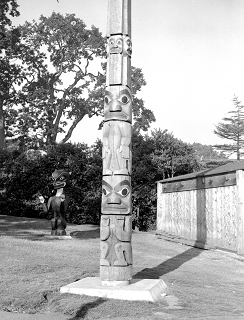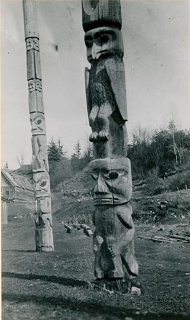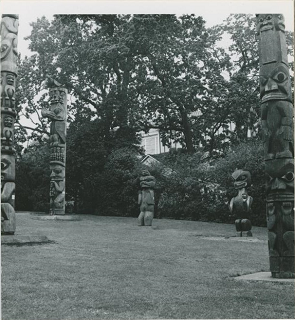Replica Memorial Pole (RBCM 20123)

The replica pole newly erected in Thunderbird Park, 1954. I-26969.

The pole commemorating the chief called Wistis is on the left in this photograph of Gitsegukla. PN 8971.

Detail of the crest Three-Beings-Across on the original pole in storage at the Royal BC Museum (RBCM 17367 a-c).

Detail of one of the Corner Post Figures on the original pole in storage at the Royal BC Museum (RBCM 17367 a-c).

The replica of the pole from Gitsegukla is on the far right in this photograph of Thunderbird Park taken in 1977. The replica of the Great Protruding (Being) from the Lake pole, also from Gitsegukla, is on the far left. Between are the replica of the Skim-sim and Will-a-daugh pole from Gitanyow and two Nuxalk grave figures from Talyu. Andrew Neimann photograph. PN 13195-13.
This is a replica, carved in Thunderbird Park, of a memorial pole from the Gitxsan community of Gitsegukla, formerly known as Skeena Crossing, that was carved around 1900 in memory of a chief known as Wistis and erected by the man who succeeded to his chieftainship. It was acquired for the provincial the museum in 1953 (RBCM 17367 a-c) by curator Wilson Duff, who considered Gitxsan memorial poles to be “the finest of their kind in existence.” The following year, working from the original pole and from photographs, Mungo Martin, David Martin and Henry Hunt created the new pole in their own version of the admired Gitxsan style. Thus the pole is both Kwakwaka’wakw and Gitxsan, but raised in the traditional territories of the Coast Salish Lkwungen peoples in Victoria. Like the other Thunderbird Park replica poles, it is a museum-created hybrid that disrupts conventional categories of function, meaning and place.
The figures on the pole are the crests of the chief’s family. At the top sits Living Eagle, a mythical bird. Below an uncarved length of pole are crests that refer to a famous house of the chief’s lineage, Three-Beings-Across; the small figures (shown twice) commemorate the six human faces that were carved on the house’s rafters; and at the bottom of the pole, two figures called Corner Post Figures, which refer to the human figures carved on the corner posts of the former house.
Do you have a story to share about this item? Add your voice to the community.